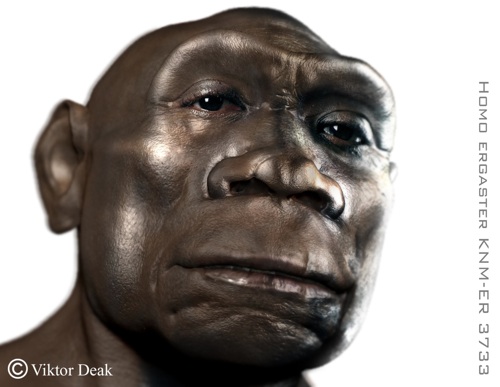|
Portrait of a paleo-artist
Paleo-artist Victor Deak is a talented reconstructor of hominids, as can be seen in the collection of his work at his website. His Homo heidelbergensis (here’s a larger image) is compelling and evocative of a past world. His reconstructions are not politically correct, as can be seen in his head of Australopithecus afarensis (larger image), who clearly is an ape, not a human, having no human nose and mouth but two ape-like apertures and an ape-like muzzle. Meaning that Lucy, notwithstanding the term “hominid,” was not humanlike but essentially an ape that walked upright. That is a very different treatment of Australopithecines from the life size illustration I saw years ago in the Hall of Human Evolution at the American Museum of Natural History that showed an Australopithecine couple walking along together across a plain, holding hands, just like a human couple. Unfortunately, Deak himself sometimes employs his talent in service to this type of PC sentimentality. On the main page of his website is a reconstruction of Homo ergaster, considered to be in between Homo habilus and Homo erectus. While the head shape and features are very primitive, the eyes are sensitive and thoughtful, and the facial expression is that of, well, a philosopher sadly contemplating the meaning of human life. This is ridiculous fiction worthy of a Disney movie. Homo ergaster did not have human language in which to form thoughts. He didn’t even have a forehead.

“What a piece of work is Homo ergaster! How noble in
Indeed, as can be seen in a profile of Deak (pronounced DAY-ahk) in the June 2 New York Times, he is an unpleasant, brutish looking fellow who on his first date with his wife took her to the grotesque Bodies exhibit, and who has a grievance against the human race for having replaced his beloved pre-humans:
It’s not just that as an artist, Mr. Deak has little patience for contemporary art. It’s that he disapproves of pretty much everything from the last 100,000 years, the entire Homo sapiens canon.And of course Deak shares the PC horror at creationists:
But the real controversy, Mr. Deak said, is in the idea his work represents. When he was waiting tables as a student, he served a family that had just visited the natural history museum. When he said he worked there part time, they were excited—until he said he worked on the Hall of Human Origins.Imagine that. Not only did Deak feel a “chill of fear” at this harmless family, as though in the presence of something evil, but he still feels it now when he thinks of them, many years later. Liberals are tolerant and approving of everyone and everything, except for non-liberals, whom they regard is irredeemably Other. Nothing human is alien to them, except (Christian) fundamentalists.
Rose writes:
Sentimentalization of our primitive ancestors was the reason I turned off the BBC’s Walking with Cavemen despite having looked forward to the special. One segment was dedicated to the famed “Lucy,” with the narrator, Alec Baldwin, describing her supposed mental states, as in “Lucy is overjoyed and relieved to find food…” “Lucy feels grief and regret at the death of her beloved child…” Attributing those high human emotions to what was (very) little more than an animal was too ridiculous for me to continue watching. When exactly consciousness came about is a very interesting topic of study and speculation, but no progress will be made towards finding an answer unless one posits a distinction between the human mind and the animal mind to begin with.Roger G. writes:
Your paraphrase of Hamlet reminds me that in high school, I played the Prince of Morocco in The Merchant of Venice (I begged for the part of Shylock, but it went to a much better actor). Does that role disqualify me from reading VFR?LA replies:
Here are my (very regretful) second thoughts about The Merchant of Venice and anti-Semitism, posted in 2006. Posted by Lawrence Auster at June 09, 2009 02:17 PM | Send Email entry |